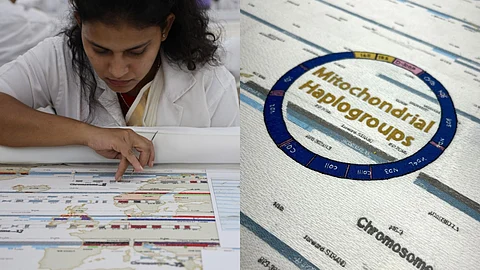
- HOMEGROWN WORLD
- #HGCREATORS
- #HGEXPLORE
- #HGVOICES
- #HGSHOP
- CAREERS
- ABOUT US
- CONTACT US

There are maps drawn in ink bound by the limits of borders, territories, and human conflict. And then there are maps woven into our very being, stitched into the fabric of our existence; stories, history, and little pockets of identities, carried through generations in the silent language of DNA. Unlike the cartographies of nations, these maps are, unaffected by the artificial constructs of time and geography.It is in this silent transmission of lineage that Genes Mundi finds its voice.
Curated under the visionary eye of Karishma Swali, Genes Mundi is a project that exists at the threshold of science, art, and craft, charting the vast, intricate networks of human ancestry through the delicate, disciplined medium of embroidery. Presented by the Chanakya Foundation in collaboration with the Consulate General of Italy and the Istituto Italiano di Cultura, Mumbai, this ambitious undertaking is the work of Italian artist-in-residence Daniela Papadia. At its heart, it is a meditation on matrilineal heritage, a painstakingly hand-stitched exploration of the Mitochondrial Eve — the primordial 200,000 year old common matrilineal ancestor of all humans, whose DNA still exists in the cells of every living person today.
Daniela Papadia’s six large-scale embroidered planispheres unravel the history of human migration, each golden thread marking the mutations in mitochondrial DNA that have woven together the great tapestry of human history. Crafted by the skilled women artisans of the Chanakya School of Craft, these works highlight endurance and continuity, binding scientific inquiry with artistic devotion.
Dedicated to Maria Grazia Chiuri, Creative Director of Dior’s women’s collections, Genes Mundi reframes embroidery as something far beyond ornamentation. Here, it is a form of cartography; one that charts both the evolution of humanity and the resilience of feminine labour. The use of cotton, jute, linen, and Lurex threads, stitched through with techniques such as couching and flung stitching, creates a layered dialogue between materiality and meaning. The artisans’ hands have transformed the conceptual into the tangible, turning ancient science into contemporary visual language.
For Karishma Swali, this exhibition is yet another step in the ongoing mission of the Chanakya Foundation’s Artist Residency program, which has been nurturing dialogues between traditional craft and contemporary art. Following the success of its inaugural residency with French-Cameroonian artist Barthélémy Toguo, this latest chapter continues to break boundaries, redefining the space embroidery occupies in the artistic canon. The Chanakya Foundation’s work is deeply rooted in the belief that craft is not a relic of the past but a living, evolving language. One that, much like mitochondrial DNA, carries forward the stories of those who came before, whispering them into the the future.
Beyond the medium of embroidery itself, Genes Mundi becomes a space for reflection — on origins, on interconnectedness, and on the silent but indelible influence of the women who have shaped history. In this intricate weave of science and art, a truth emerges: our ancestry is not something behind us, fixed and finished. It is something we continue to carry and pass on.
Follow Chanakya school of craft here.
If you enjoyed reading this here's more from Homegrown:
Mumbai Exhibition 'My Peeking Red Bra Strap' Examines The Policing Of Women's Bodies
Gauri Gill's Powerful Exhibition Captures The Resilience Of The 2021 Farmers' Protests
Yogesh Ramkrishna's Debut Solo Exhibition Spotlights The Absurdities Of The Status Quo
